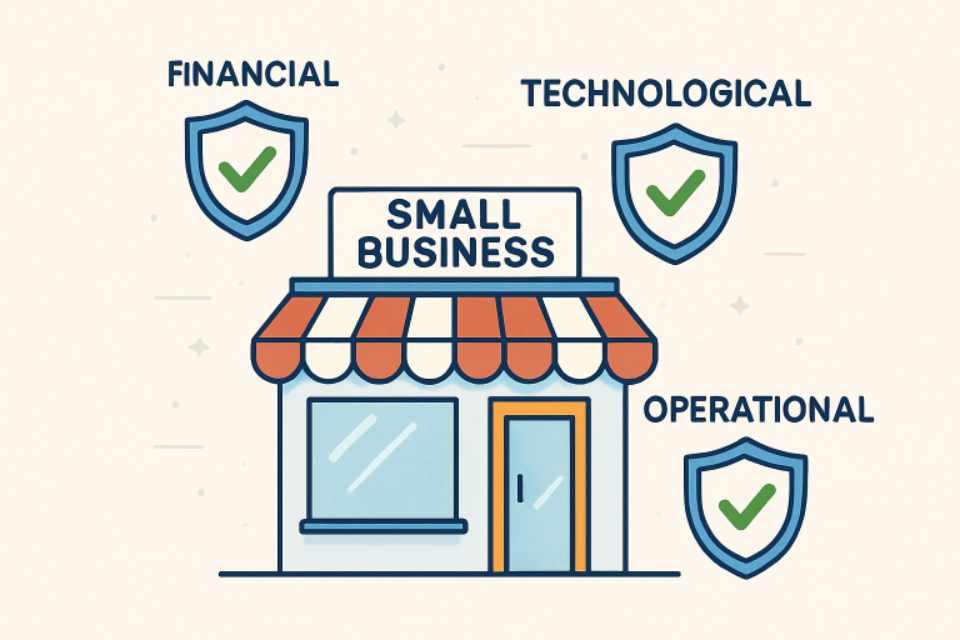Introduction
In today’s fast-paced and unpredictable business landscape, small businesses are particularly vulnerable to a wide range of operational, financial, technological, and reputational risks. Unlike large corporations, small businesses often lack the resources to fully absorb the impact of a single crisis or costly lawsuit. That’s why taking proactive measures to address risks is not only wise but also essential for sustaining operations and driving long-term growth. One of the foundational steps every small business should take is obtaining adequate liability protection for small businesses. Liability insurance shields companies from unexpected legal claims, settlements, and judgment costs that could otherwise cripple or bankrupt a business. However, comprehensive risk management is about much more than just securing legal protection—it’s about building a resilient organization, one that’s capable of adapting to unpredictable events and emerging stronger from adversity.
Integrating robust risk management processes within your company’s framework does more than help you sidestep pitfalls; it also enables you to anticipate and mitigate potential risks. It opens the door to sustained stability and competitive advantage in a rapidly changing marketplace. By identifying potential hazards, developing contingency plans for the unforeseen, and implementing proven risk mitigation strategies, small businesses can safeguard their operations, protect their financial and physical assets, and maintain their reputation. Above all, sound risk management builds confidence among employees, customers, and stakeholders, reinforcing the business’s foundation and fortifying relationships that are key to support through challenging times.
Identifying Common Risks
Comprehensive risk management begins with a clear-eyed understanding of the daily threats that loom over small businesses. These risks are both varied and evolving, ranging from financial uncertainties, such as fluctuating cash flows, unexpected increases in expenses, or late payments, to operational disruptions, including supplier failures, equipment breakdowns, or natural disasters. Legal liabilities from customer complaints, employee disputes, and contractual breaches also present significant challenges. Meanwhile, reputational risks—stemming from negative reviews, social media missteps, or public relations crises—can damage a business in ways that are difficult to repair and can quickly erode customer trust.
To effectively protect against these potential hazards, small business owners should regularly evaluate both internal and external risk factors. Internal reviews should look for vulnerabilities such as deficiencies in staff training, outdated systems, or overdependence on a few high-value clients. Externally, staying informed about industry regulations, the economic environment, competitive shifts, and technological advancements is crucial. Regular risk assessment enables businesses to prepare more efficiently and enhances their overall resilience. By prioritizing the identification stage, small businesses lay a solid groundwork for the next critical steps of their risk management journey.
Developing a Risk Management Plan
Once risks are identified, the next step is to craft a detailed risk management plan that outlines your strategy for mitigating those threats. A structured plan should encompass several vital elements:
- Risk Assessment: In this process, businesses rank risks based on their likelihood and potential impact. This involves considering scenarios ranging from minor disruptions to worst-case events and quantifying how they might affect financial performance, regulatory compliance, customer relationships, and overall business continuity.
- Mitigation Strategies: This section focuses on proactively minimizing the identified risks. This could involve investing in backup inventory or equipment, requiring vendor contracts with clear protections and contingencies, implementing stricter hiring and training programs, or enhancing on-site safety protocols.
- Response Planning: No risk management strategy is complete without a well-defined response plan. This includes developing action steps for various incidents, training staff on emergency roles and communication protocols, and conducting simulations. A quick and coordinated response can significantly reduce the impact of emergencies, preserving both reputation and revenue.
Despite the potential consequences, a recent report found that only 54% of small business owners feel highly protected against the most significant threats facing their companies. This stark statistic underscores the importance of creating, maintaining, and regularly updating risk management plans, rather than treating risk as a one-time consideration.
Implementing Cybersecurity Measures
In an era where digital transformation is central to business growth, cybersecurity has become a crucial component of a comprehensive risk management strategy. Cyberattacks such as ransomware, phishing, and data breaches are not just threats to large corporations—small businesses often lack robust defenses, making them prime targets. The aftermath of even a single attack can include hefty recovery costs, regulatory fines, lost intellectual property, and a scarred reputation.
- Conduct frequent security audits to swiftly detect weak points and close security gaps before exploitation occurs.
- Adopt and enforce strong password management policies, require multi-factor authentication for all sensitive accounts, and limit user access to vital systems and data based on roles.
- Implement ongoing employee cybersecurity training. Since staff are often a target for attackers, continuous education on phishing, social engineering tactics, and safe data practices is indispensable.
Approximately 74% of data breaches in 2023 involved human error, vividly highlighting that regular education—and not just technology—remains a frontline defense for small businesses in cybersecurity, making vigilance not only recommended but also necessary.
Financial Risk Management
Financial risks, if unmanaged, can swiftly destabilize even the most profitable small businesses. Fluctuating sales, rising operating costs, slow-paying clients, and a lack of diversified income streams expose companies to harmful financial shocks. Effective financial risk management entails meticulous planning and ongoing monitoring.
- Maintain a steady cash flow through disciplined invoicing, regular financial reviews, and keeping a buffer for slow sales periods or emergencies.
- Diversify revenue sources to avoid being overly dependent on one client, product, or service. It can include expanding into new markets, introducing new product lines, or exploring alternative sales channels.
- Pursue targeted insurance coverage—such as property, commercial liability, cyber, and business interruption insurance—tailored specifically to the nature and scale of your operations.
Collaborating closely with financial advisors and leveraging smart accounting software enables small-business owners to identify warning signs of trouble early and adapt quickly. Active financial oversight not only protects profits but positions companies to seize growth opportunities as they arise.
Leveraging Technology for Risk Assessment
Modern technology has transformed how small businesses approach risk management, enabling more sophisticated, data-driven strategies that were previously only accessible to large enterprises. Key benefits of leveraging technology for risk assessment and mitigation include
- Real-time data analytics tools provide immediate insight into business operations, flagging suspicious activity or emerging dangers, and allowing owners to react instantly rather than after damage occurs.
- Automated compliance software ensures that businesses continually meet shifting regulatory requirements, thereby reducing the risk of costly fines or penalties resulting from oversight or reporting errors.
- Enhanced communication platforms streamline both internal and external coordination, ensuring that the entire team is informed and able to act swiftly when incidents arise.
Cutting-edge technologies, such as artificial intelligence, predictive modeling, and machine learning, can aid in forecasting risks with greater accuracy. Small businesses can then preemptively shore up their operations, avoid costly setbacks, and pivot strategically to outpace their competitors.
Regular Review and Adaptation
Risk management is far from a “set it and forget it” exercise. The rapidly evolving landscape of regulations, economic fluctuations, emerging technologies, and consumer preferences means that threats—and opportunities—constantly change. Small businesses should cultivate a culture of constant vigilance by establishing regular intervals for reviewing and updating their risk management strategies, policies, and insurance coverage as the company expands or enters new markets. Periodic risk audits, scenario planning, and seeking insights from risk management professionals help sharpen the ability to spot new challenges and reinforce business continuity measures.
Ultimately, organizations that weave comprehensive risk management practices into their business model—supplemented by reliable liability protection for small businesses—are better positioned to shield their assets, foster trust, and ensure steady, sustainable growth. By embracing a proactive rather than reactive mindset, small businesses set themselves up not only to survive disruptions but also to seize new opportunities with greater confidence, regardless of what the future brings.





